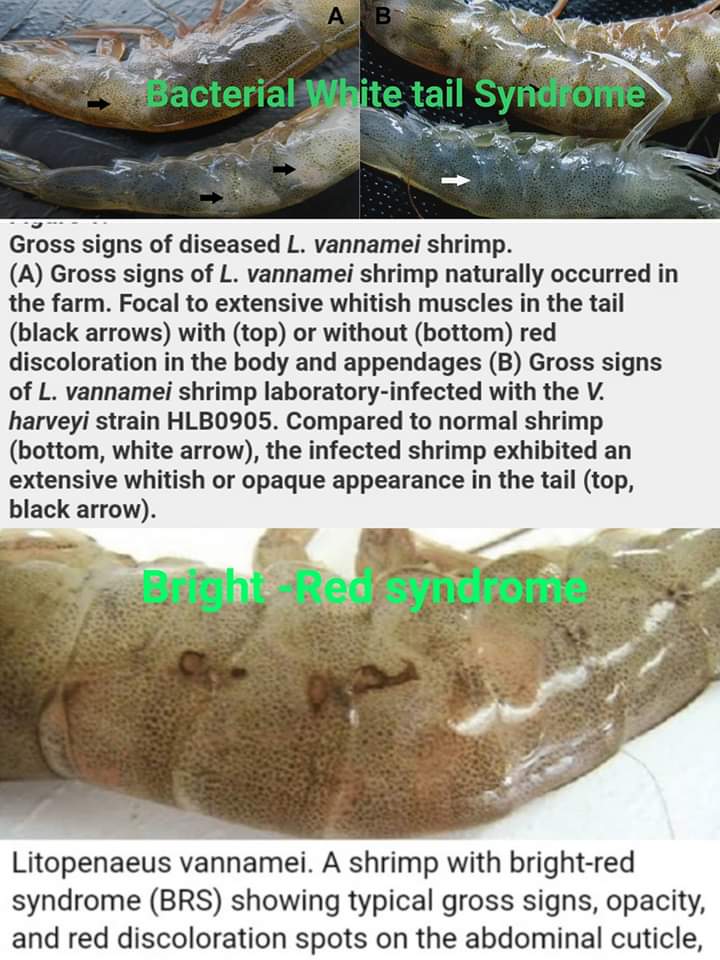By Sri S.Rajamanickam
Asst.Chief Technical officer
ICAR-CIBA
Nonluminescent Vibrio harveyi strain HLB0905 and Vibrio harveyi strain CAIM 1792 could cause mass mortality in shrimp culture pond.
Nonluminescent and highly virulent Vibrio harveyi strain HLB0905 is associated with “bacterial white tail disease” of Litopenaeus vannamei shrimp. This mass mortality disease in pond-cultured juvenile and subadult Litopenaeus vannamei shrimp in several districts in China remain an important problem in shrimp culture period.
The disease was characterized by “white tail” and generally accompanied by mass mortalities. Based on data from the microscopical analyses, PCR detection and 16S rRNA sequencing, a new Vibrio harveyi strain (designated as strain HLB0905) was identified as the etiologic pathogen. The bacterial isolation and challenge tests demonstrated that the HLB0905 strain was nonluminescent but highly virulent. It could cause mass mortality in affected shrimp during a short time period with a low dose of infection. Meanwhile, the histopathological and electron microscopical analysis both showed that the HLB0905 strain could cause severe fiber cell damages and striated muscle necrosis by accumulating in the tail muscle of L. vannamei shrimp, which led the affected shrimp to exhibit white or opaque lesions in the tail. The typical sign was closely similar to that caused by infectious myonecrosis (IMN), white tail disease (WTD) or penaeid white tail disease (PWTD). To differentiate from such diseases as with a sign of “white tail” but of non-bacterial origin, the present disease was named as “bacterial white tail disease (BWTD)”. Present study revealed that, just like IMN and WTD, BWTD could also cause mass mortalities in pond-cultured shrimp. These results suggested that some bacterial strains are changing themselves from secondary to primary pathogens by enhancing their virulence in current shrimp aquaculture system.
One of the another Vibrio harveyi strain CAIM 1792 caused by mass mortality in Mexico shrimp farmers pond.Moribund Litopenaeus vannamei associated with mass mortalities were lethargic and displayed red discoloration spots on their abdomen, and hence were called bright-red by
farmers. Shrimp submitted for diagnosis were examined using wet tissue mounts, bacteriological
assays and their respective minimum inhibitory concentration (MIC), and histology. A dominant
yellow bacterial colony was isolated in thiosulphate citrate bile salts-sucrose (TCBS) agar and identified by molecular methods as Vibrio harveyi strain CAIM 1792. Pathogenicity of the V. harveyi strain
was demonstrated in L. vannamei. The lowest MIC against Vibrio isolates from bright-red shrimp was
obtained with enrofloxacine (3.01, SD = 5.96 µg ml–1). Histology detected severe necrosis in lymphoid
organ tubules, muscle fibers, and connective tissue, as well as melanization and hemocytic nodules
associate with microcolonies of Gram-negative bacilli. Bacteria from severely affected shrimp were
dispersed from the haemocoel to other tissues causing a systemic vibriosis. The data indicate that
V. harveyi strain CAIM 1792 is the cause of bright-red syndrome (BRS) and represents a threat to the
Mexican shrimp farming industry.
Indian shrimp culture farmers facing this types of running mortality syndrome continuously. Hepatopancrease related disease of NHP and gastrointestinal tract related disease of white feces disease also could cause running mortality syndrome – So, more knowledge need.


